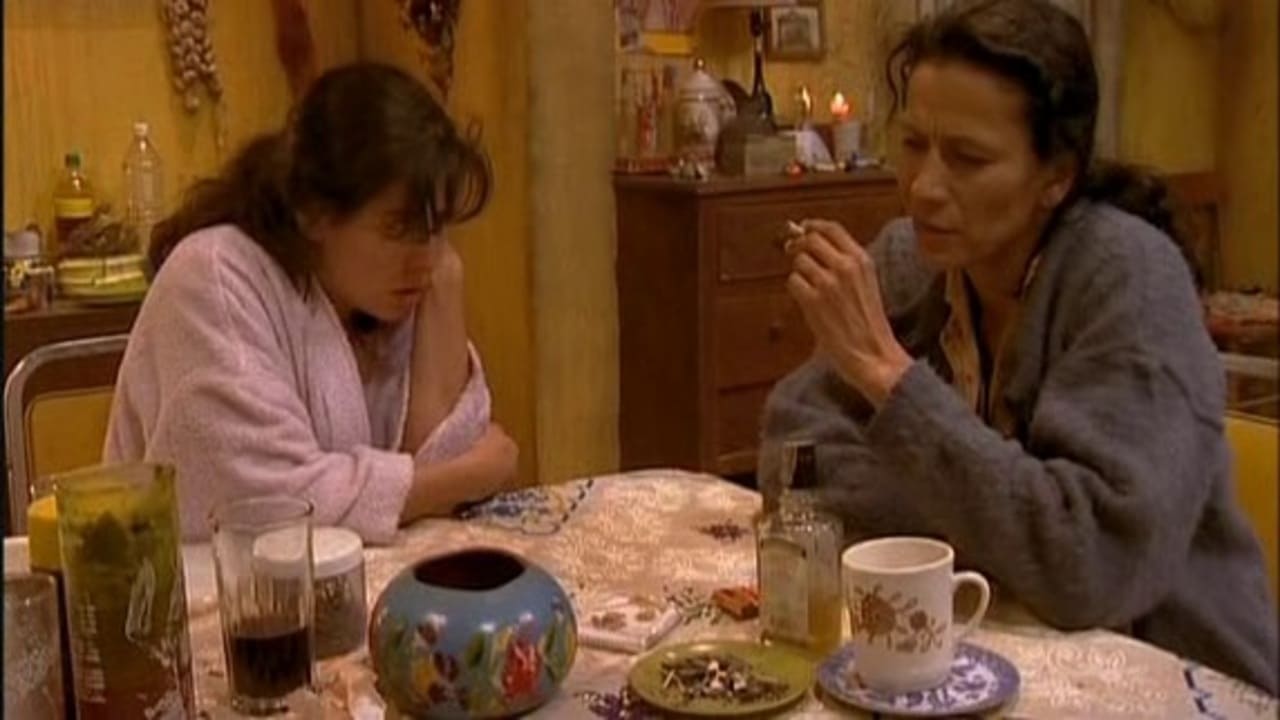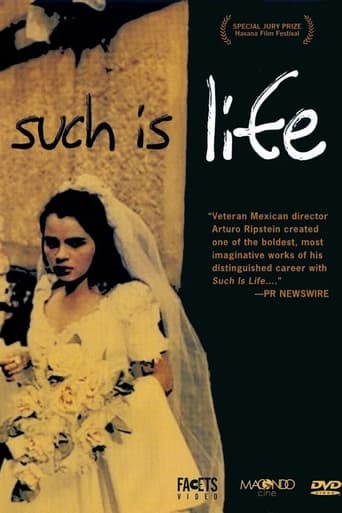SpuffyWeb
Sadly Over-hyped
Ameriatch
One of the best films i have seen
Sexylocher
Masterful Movie
Jakoba
True to its essence, the characters remain on the same line and manage to entertain the viewer, each highlighting their own distinctive qualities or touches.
susannettashop
Ripstein and his wife and screen writer Paz Alicia Garciadiego have made a faithful version of the hideous tragedy of the Roman Seneca's Medea, moved and updated to a small, claustrophobic neighborhood in Mexico City. We watch as Julia, an abortionist and curandera, abandoned for a younger and richer woman by her husband, a small-time pugilist named Nicolas, maintains a self-destructive fury that ends in her murder of their two children. Even as a classicist, I am bothered rather than cheered by Ripstein's faithfulness to Seneca's tragedy. This is because Asi es la vida is theatrical rather than cinematic: except for showing the back of a mysterious silver van, an ambulance that may represent fate, Ripstein confines his mise-en-scene to interiors and exteriors that could have been stage sets. So, like Seneca's tragedy, the film feels static. Additionally, there is no development of the characters, who get angry and stay angry. Is it because he is in sympathy with Seneca that Ripstein misses the advantages of film? He does not paint with a world of images and memories to give a full picture of characters and to fill in the story. Instead, the subconscious of the Julia (the Medea character) and her almost ex Nicolas (the Jason character) close in rather than opening out cinematographically. The chorus could drive you crazy! It is a depressing mariachi band with an affectless boy listlessly shaking his marraccas who sing what Medea is feeling, first in her presence and later from a TV screen. Her stormy feelings are also read weather channel. The TV also stands in for Jason's lust, playing porn as he makes love to his new sweety. These devices, the chorus, the TV, and the mysterious van, rather than matching or contrasting images give the film coherence. If it is an anti-film, Asi es la vita does not add much to the dialog between men and women. Julia is every abandoned woman who has no identity and no value apart her husband and her children. Using Seneca's tragedy to tell us that little has changed in the war between men and women since Roman times is gratuitous. As Julia, Arcelia Ramirez is believable as she bangs her head against the wall and punches herself making her face bleed, to the accompaniment of the mariachis, but under Ripstein's direction I am afraid that the film is exploitative rather than revealing. A weird sense of humor undercuts the tragedy. The King figure, Julia's landlord and the father of Nicolas's love interest, for example is a hugely fat man who waddles around the barrio in a robe and slippers. The Pig, as he is known, along with the semi-serious mariachis, the weather channel and the porn films, the yellow cab in which Julia escapes after committing double murder all belong to the tradition of the theater of alienation. These devices are too small for the big screen. Ripstein's film does not make as good use of the techne and resources of cinema as Lars von Trier's or Pasolini's versions of Medea.
Keith F. Hatcher
The sublime, visual poeticness of `El Coronel no tiene quién le escriba' (qv), without any doubt one of the most beautiful films in Spanish from either side of the Atlantic, used beautiful photography, music and two excellent actors to build up an exquisitely atmospheric film evoking sincere pathos, such that the impact is tenderly psychological.With `Así es la Vida' all that has gone; the subtleties of `El Coronel no tiene quién le escriba' (Gabriel García Marquez) are thrown out in favour of double-handed axe blows which obviate the outcome way before you get there. It seems as if Arturo Ripstein sought to bombard the spectator into oblivion with a pathologically overwrought story reaching extremes of visual violence which are not really justified. In this, his wife, Paz Alicia Garciadiego, is to blame. Her careful adaptation of Gabriel García Marquez's short novel, here becomes a `machaconic' bombast of disproportionate savagery. The film kills itself from its own blunt heavy-handedness, such that one tends to think that Mrs. Garciadiego-Ripstein was hell-bent on vomiting up her own masochistic `macho' feelings, rather than telling the story in a more heart-felt way: the result on the viewer may well have been just as powerful, without resorting to such exaggerated extremes.Neither the presence of Tovar nor Yáñez lend much to the proceedings, unfortunately: the film derails around them. Added to that is the frustration of trying to work out a very marked Mexican accent which often left me half-guessing some of the dialogues. I do not usually have any difficulty with the regional varieties of Spanish on the American side of the Atlantic, but in this film, the going was definitely `muy chingadera'.I hope that a far better conclusion can be made after seeing the next Ripstein-Garciadiego film – `La Virgen de la Lujuria' – with Ariadna Gil and Juan Diego. If not, I can only suggest that Ripstein change scriptwriter, if not wife………..
Edgar Soberon Torchia
Ripstein is México's most respected filmmaker. He belongs to the 1970's generation responsible for the so-called "new Mexican cinema", which produced some great works, as Paul Leduc's "Reed: México insurgente" and Felipe Cazals' "Canoa". Ripstein was one of the first to gain recognition with his very good B&W film, "Tiempo de morir" (1965), written directly for the screen by Gabriel García Márquez, with dialogues by Carlos Fuentes. It has rained a lot between this movie and his 1999 screen adaptation of García Márquez' novel "El coronel no tiene quien le escriba". In the meantime, he married screenwriter Paz Alicia Garciadiego, and since their first collaboration, "El imperio de la fortuna" (1986, after Juan Rulfo's story "El gallo de oro"), Ripstein's cinematic world has become overblown, slow, morbid, grotesque and misanthropic. One cannot blame Garciadiego for this, but she surely has a lot to do with it. "Profundo carmesí" (1996), their remake of the story told in "The Honeymoon Killers", is a good example of this couple's peculiar taste. In "La perdición de los hombres" and "Así es la vida" (both 2000), Ripstein once again enters the world of misery, though his characters are not precisely outcasts, as the fat nurse and her gigolo lover. This time he returns to his early free-style as he tells the stories of normal people, who choose weird solutions to their predicaments and whose dreams occupy on the screen the same space, an in the same tone and register, as their daily actions. If "La perdición de los hombres" is fine, things do not work that well with "Así es la vida", based on the myth of Medea as told by Roman playwright-moralist Seneca. While Euripides was sort of questioning polytheism in his tragedies, Seneca -born almost 500 years later- lived in the midst of the origins of Christianity, so the "moira" (destiny) and the Olympus gods were at stake. Medea (so admired by feminists) has never escaped criticism as a character that hardly can claim that Zeus or Destiny forced her to commit her crimes. Garciadiego knows this, so in trying to adapt the story to contemporary times, she introduces telling images of dysfunctionality (her Julia/Medea is viciously abusing herself because of her addictive relationship), but the screenwriter is at odds when she deals (she rather does not) with the religious and magic thoughts that impelled Medea's original actions: in this version they are almost absent. Julia/Medea (Arcelia Ramírez in a very good performance, considering what Ripstein and Garciadiego put her through) does practice "witchcraft" (by performing cheap abortions and silly spells), she has visions of her rival being destroyed by fire, and though Ripstein recurrently introduces the image of a golden van running through México City streets, there's no magic and nothing makes much sense, the less when Julia/Medea leaves home in a yellow taxi, as if nothing... On the other hand, Garciadiego's misanthropy is useful to explain Nicolás/Jason's actions, as in a very good sequence when Nicolás/Jason (Luis Felipe Tovar, a young Mexican Christopher Lee who seems to be in most Mexican movie these days) declares the "macho manifesto" while boxing. Wonderful Patricia Reyes Spíndola is also at hand and repeats her characterization from "La perdición de los hombres", this time as Julia/Medea's godmother, but I could not help feeling like a pitiless voyeur, watching these low class characters being described with so much ridicule and lack of sympathy.
B & M
Así es la vida is the first latin american digital film transfered to 35mm. For those who didn't understand it, it's a contemporary version of Sénecas' Medea, a greek tragedy. So don't complain about the script because that was the intention of all that complex language. Based on this story, the film is excellent, the scenario and the ambient are very well mixed with the movement of the camera, so you get long scenes but not monotonous. For me, displaying the trio as a the chorus of a greek play was an excellent idea. Although is a little strange film, a Ripstein's film, for me the way they treated the character of Julia wasn't that strange. How she remains homeless happens at least here in Mexico City, how she is cheated, etc. So it's curious how a very old tragedy it's well adapted to our days. So, finally, it's a very good experiment in digital video, it's a simple story maybe, but with a lot of details on it.

